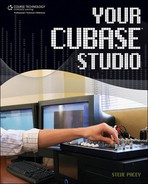Building a Mix in Cubase
The first step in mixing is isolating the most important part of the mix and making it sound as good as possible. The best way to accomplish this is by first listening to all of the tracks and then deciding which is the most important. Once you know that (the element might be on multiple tracks), you then mute the remaining tracks and concentrate on that part.
To mute the other tracks in Cubase, click the Mute button for each individual track (see Figure 9.1) using the OST (Object Selection tool).
Figure 9.1. A track’s Mute button.

Once the other parts are muted, focus on your most important part. Make sure that there are no audible editing glitches. Listen to the part from start to finish. Is the level consistent throughout the track or tracks? Consider this part the foundation of your entire mix. Without it, the rest of your mix will fall apart as you build it. At this point you will want to make level adjustments and add any effects to this part until you’re sure you will be satisfied come the final stage of mixing (more on making level adjustments and adding effects later in this chapter).
Once you are completely satisfied with your foundation track(s), add the next most important part of the mix by selecting and unmuting the appropriate tracks in Cubase. Take the time to listen to how adding this new part has changed the sound of your first part. Now it’s time to compromise between the foundation and the newly added track. This could consist of lowering the volume or changing the EQ of the new track, the foundation track, or both. Does the newly added track sound as good as it can sound? Could the track stand alone? It also may be necessary to solo the newly added track to hear how well the new addition to the mix stands by itself. To solo a part, click the Solo button for that particular track (see Figure 9.2). When soloing, you can make adjustments to the level or EQ to listen to how it affects the part. When you are finished making adjustments, deactivate the solo and once again listen to the foundation track and the newly added track together. Continue this process, with adjustments, until you are completely satisfied with the way these two parts work together.
Figure 9.2. The Solo button on a track.

This process of adding parts to a mix is known as building a mix. You should continue to add tracks, making larger adjustments to the newly added part and minor adjustments to the foundation parts. Once all the tracks have been added and all adjustments have been made, you should be ready to either export the mix or start getting more creative with it (more on both of these later).
As you’re building your mix, you might find that things start to fall apart, start sounding much less defined than they originally did, or that, overall, the mix just doesn’t cut it. It may be necessary to either start over with a new mix or retreat from your last several steps. One of the best ways to take a few steps back in Cubase is by using the Edit History (accessible from the Edit menu). The Edit History acts as a list of every action you made when working in Cubase since the project was opened (see Figure 9.3). The last action taken is at the top of the list, and the first action is at the bottom of the list. By clicking on a prior action, you will restore the project to that state, and this will allow you to create new actions from that point. You can also use the Undo feature in the Edit menu, but sometimes it takes several steps to get back to a place where you can restart.
Figure 9.3. The Edit History window is useful for backtracking as you build your mix.

